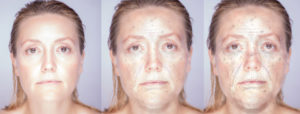
Turn Your Golden Faces Into the Sun, Just Put on Sunscreen First
Ever wonder what your skin would look like in 5, 10, or 25 years? Will you have dark spots, wrinkles, or, worse, skin cancer?
We don’t have any working crystal balls, that I know of yet, but there are ways to see into the future of our skin.
How to Get a Photo Assessment of Your Skin:
You may be able to find a clinic that offers photo assessments of your skin like the Visia Skin Complexion Analysis or Optic Slim Skin Analysis. These show your current level of UV damage and provide a valuable glimpse into future damage and how your skin will age.
Some clinics will provide this service for free and then provide treatment recommendations which are not free. Other clinics charge for this service like any other service. In any case, the pictures can be a sobering reminder of what damage we are doing to our skin without realizing it.
A Selfie Photo Assessment:
Another option, if you don’t want to make a trip to a clinic, is to use a selfie-app. I just downloaded a free facial-aging app called Sunface. It was developed by Dr. Titus J. Brinker who is a medical doctor and developer of multiple behavioral intervention apps in smoking and melanoma prevention (in addition to Sunface, he also developed Smokerface).
The app shows how your skin would look in 5, 10, 15, 20, and 25 years with sun protection, without sun protection, and with weekly tanning. It’s pretty amazing how much damage can occur in as little as 5 years!

I also love that the selfie you take becomes animated. Your eyes blink and your head moves side to side and up and down. If you leave the selfie idle for a little while you will sigh/yawn, clear your throat and cough. You can also share your results easily.
The Sunface app is available for both Apple and Android devices. It’s terrifying and fun all wrapped up in one app.
References:
Titus, Brinker, J. “Facial-Aging App Availability in Waiting Rooms as a Potential Opportunity for Skin Cancer Prevention”JAMA Dermatology https://jamanetwork.com/journals/jamadermatology/article-abstract/2687977




